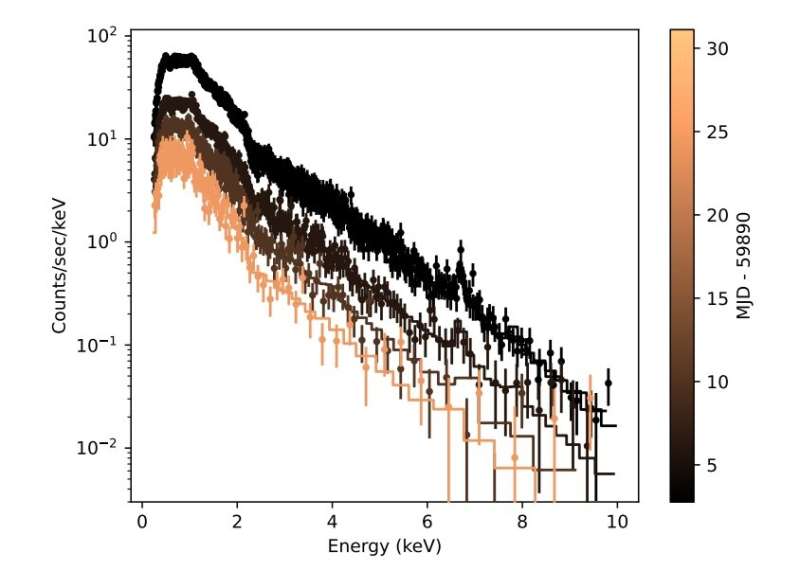Astronomers have observed a powerful X-ray superflare from the giant star HD 251108, located 1,646 light-years away. The flare, which lasted for over 28 days, was studied in unprecedented detail using the NICER spacecraft and ground-based telescopes. The observations provide insights into the magnetic activity and flaring behavior of this evolved, K-type giant star. Studying such extreme stellar events helps scientists better understand the complex interactions between the magnetic fields and surfaces of stars.

Unveiling the Colossal Superflare on the Giant Star HD 251108
An international team of astronomers, led by Hans Moritz Günther from the MIT Kavli Institute for Astrophysics and Space Research, have observed a powerful X-ray superflare on the giant star HD 251108. The star, located some 1,646 light-years away, is an evolved and magnetically active K-type giant that is about seven times larger than our Sun.
Using the Neutron Star Interior Composition Explorer (NICER) and various ground-based telescopes, the researchers were able to monitor the decay phase of this superflare for an unprecedented 28 days. Their findings, published on the pre-print server arXiv, reveal remarkable details about the flare’s characteristics and the underlying stellar activity.
Unveiling the Colossal Superflare: Insights into the Flaring Activity of HD 251108
The 2022 superflare on HD 251108 had a peak flux of around 10 decillion erg/s (10^33 erg/s) in the 0.5–4.0 keV band, making it one of the strongest flares ever observed. The flare also exhibited an exponential decay time of 2.2 days in the early decay phase.
Based on the collected data, the researchers estimated the length of the flare loop to be two to four times larger than the radius of HD 251108. This suggests that the magnetic field structures responsible for the superflare were massive, spanning a significant portion of the star’s surface.
Interestingly, about 10 days after the flare peak, the researchers observed a short phase of limited re-heating, and the light curve began to deviate from the initial decay. This behavior provides valuable clues about the complex dynamics and magnetic processes occurring in the stellar atmosphere during the aftermath of such an extreme event.
Furthermore, the study found that the chemical abundances of HD 251108 remained stable throughout the flare and were consistent with typical active stars exhibiting the inverse first ionization potential (IFIP) effect. This suggests that the superflare did not significantly alter the overall composition of the star’s outer layers.
Unraveling the Secrets of Stellar Magnetism: Insights from the HD 251108 Superflare
The observations also revealed that HD 251108 exhibits rotational modulation with a period of 21.3 days, which can be explained by the presence of large, stable stellar spots that rotate in and out of view. This is further supported by the star’s observed photometric variability of around 0.5 magnitudes on timescales of one or more decades.
These findings suggest that HD 251108 has a relatively stable and long-lived magnetic field structure, which is responsible for the formation of large, persistent starspots on its surface. The presence of such spots, in turn, contributes to the generation of powerful superflares through the complex interplay between the star’s magnetic field and surface features.
By studying the flaring activity of HD 251108 and other similar giant stars, astronomers can gain valuable insights into the fundamental processes that drive stellar magnetism and the explosive release of energy in these dynamic celestial bodies. Understanding the origins and characteristics of superflares is crucial for further advancing our knowledge of stellar evolution and the potential impacts of such events on exoplanetary systems.
